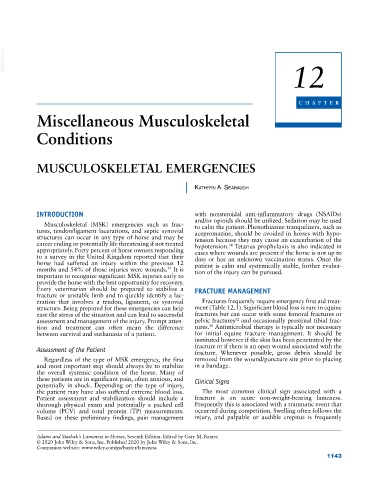Page 1177 - Adams and Stashak's Lameness in Horses, 7th Edition
P. 1177
VetBooks.ir
12
CHAPTER
Miscellaneous Musculoskeletal
Conditions
MUSCULOSKELETAL EMERGENCIES
Kathryn a. Seabaugh
INTRODUCTION with nonsteroidal anti‐inflammatory drugs (NSAIDs)
and/or opioids should be utilized. Sedation may be used
Musculoskeletal (MSK) emergencies such as frac to calm the patient. Phenothiazine tranquilizers, such as
tures, tendon/ligament lacerations, and septic synovial acepromazine, should be avoided in horses with hypo
structures can occur in any type of horse and may be tension because they may cause an exacerbation of the
career ending or potentially life threatening if not treated hypotension. Tetanus prophylaxis is also indicated in
34
appropriately. Forty percent of horse owners responding cases where wounds are present if the horse is not up to
to a survey in the United Kingdom reported that their date or has an unknown vaccination status. Once the
horse had suffered an injury within the previous 12 patient is calm and systemically stable, further evalua
months and 54% of those injuries were wounds. It is tion of the injury can be pursued.
39
important to recognize significant MSK injuries early to
provide the horse with the best opportunity for recovery.
Every veterinarian should be prepared to stabilize a FRACTURE MANAGEMENT
fracture or unstable limb and to quickly identify a lac
eration that involves a tendon, ligament, or synovial Fractures frequently require emergency first aid treat
structure. Being prepared for these emergencies can help ment (Table 12.1). Significant blood loss is rare in equine
ease the stress of the situation and can lead to successful fractures but can occur with some femoral fractures or
assessment and management of the injury. Prompt atten pelvic fractures and occasionally proximal tibial frac
52
36
tion and treatment can often mean the difference tures. Antimicrobial therapy is typically not necessary
between survival and euthanasia of a patient. for initial equine fracture management. It should be
instituted however if the skin has been penetrated by the
fracture or if there is an open wound associated with the
Assessment of the Patient fracture. Whenever possible, gross debris should be
Regardless of the type of MSK emergency, the first removed from the wound/puncture site prior to placing
and most important step should always be to stabilize in a bandage.
the overall systemic condition of the horse. Many of
these patients are in significant pain, often anxious, and Clinical Signs
potentially in shock. Depending on the type of injury,
the patient may have also suffered extreme blood loss. The most common clinical sign associated with a
Patient assessment and stabilization should include a fracture is an acute non‐weight‐bearing lameness.
thorough physical exam and potentially a packed cell Frequently this is associated with a traumatic event that
volume (PCV) and total protein (TP) measurements. occurred during competition. Swelling often follows the
Based on these preliminary findings, pain management injury, and palpable or audible crepitus is frequently
Adams and Stashak’s Lameness in Horses, Seventh Edition. Edited by Gary M. Baxter.
© 2020 John Wiley & Sons, Inc. Published 2020 by John Wiley & Sons, Inc.
Companion website: www.wiley.com/go/baxter/lameness
1143

